Business and Environment Analysis: Hoa Phat Group Investment Report
VerifiedAdded on 2021/04/05
|31
|9324
|127
Report
AI Summary
This report presents a comprehensive analysis of the Hoa Phat Group, a prominent Vietnamese company, focusing on its internal and external business environment. It begins with an introduction outlining the report's purpose and structure, followed by an analysis of the macro-environment using the PESTLE model and the competitive environment through Porter's Five Forces. The report then delves into Hoa Phat's internal factors, including its vision, organizational structure, human resources, and financial strength, identifying its strengths and weaknesses. It connects these internal factors with external macro factors, utilizing SWOT/TOWS analysis to evaluate business decision-making. The analysis includes a comparison of Hoa Phat's decisions with those of another company, highlighting the impact of similar external factors. The report concludes with a summary of key findings and a recommendation regarding Hoa Phat's potential as an investment opportunity for JP Morgan, supported by the preceding analysis. The report also includes a presentation outline.
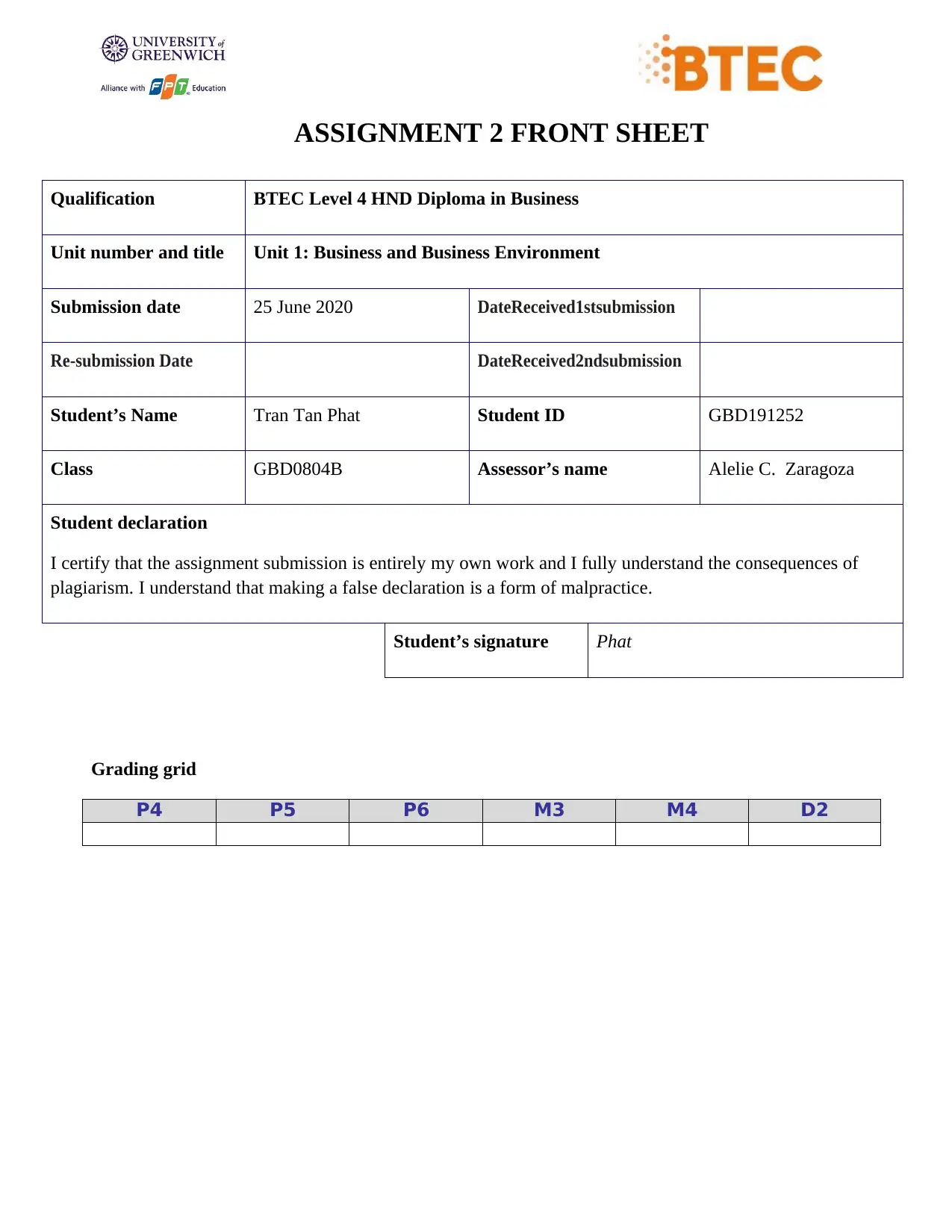
ASSIGNMENT 2 FRONT SHEET
Qualification BTEC Level 4 HND Diploma in Business
Unit number and title Unit 1: Business and Business Environment
Submission date 25 June 2020 DateReceived1stsubmission
Re-submission Date DateReceived2ndsubmission
Student’s Name Tran Tan Phat Student ID GBD191252
Class GBD0804B Assessor’s name Alelie C. Zaragoza
Student declaration
I certify that the assignment submission is entirely my own work and I fully understand the consequences of
plagiarism. I understand that making a false declaration is a form of malpractice.
Student’s signature Phat
Grading grid
P4 P5 P6 M3 M4 D2
Qualification BTEC Level 4 HND Diploma in Business
Unit number and title Unit 1: Business and Business Environment
Submission date 25 June 2020 DateReceived1stsubmission
Re-submission Date DateReceived2ndsubmission
Student’s Name Tran Tan Phat Student ID GBD191252
Class GBD0804B Assessor’s name Alelie C. Zaragoza
Student declaration
I certify that the assignment submission is entirely my own work and I fully understand the consequences of
plagiarism. I understand that making a false declaration is a form of malpractice.
Student’s signature Phat
Grading grid
P4 P5 P6 M3 M4 D2
Paraphrase This Document
Need a fresh take? Get an instant paraphrase of this document with our AI Paraphraser
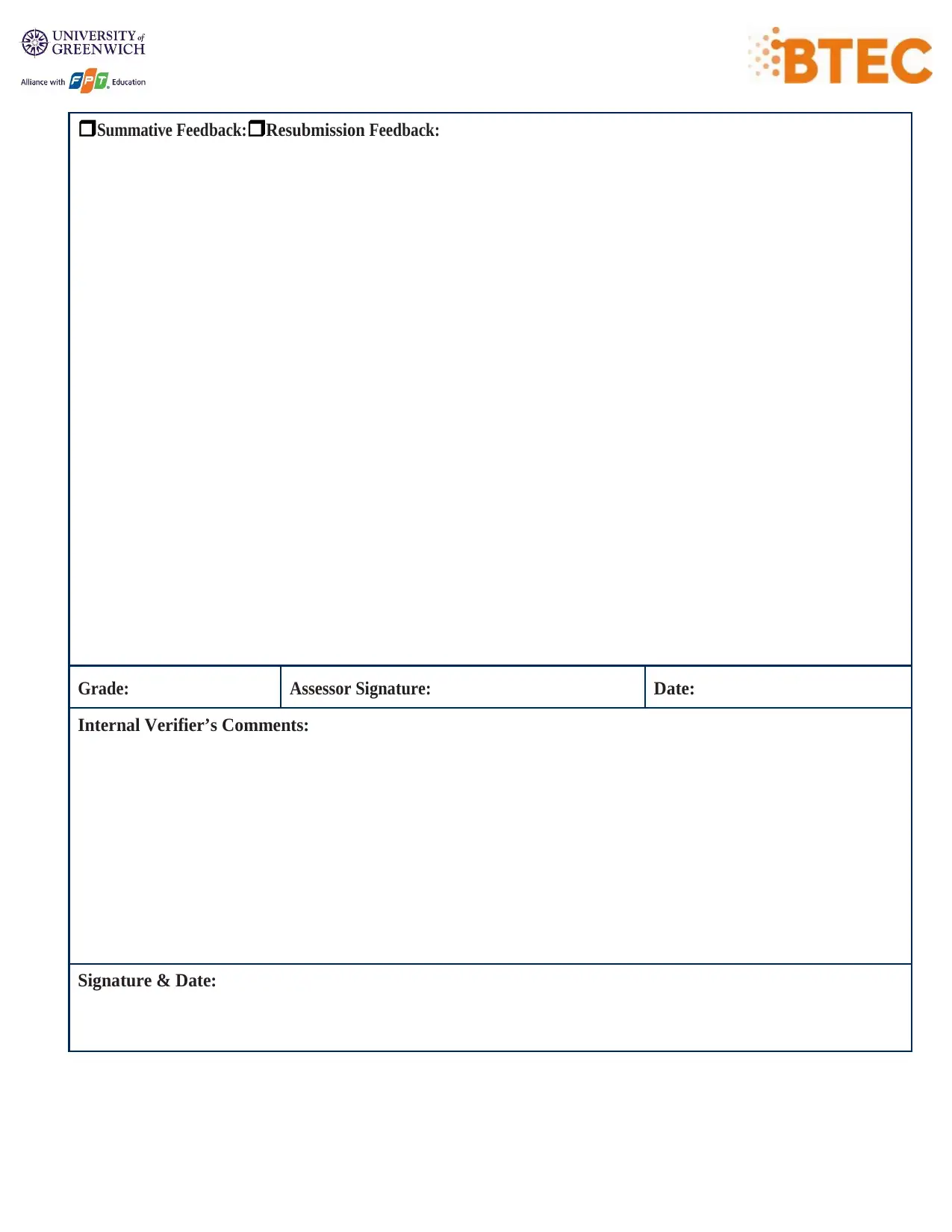
Summative Feedback: Resubmission Feedback:
Grade: Assessor Signature: Date:
Internal Verifier’s Comments:
Signature & Date:
Grade: Assessor Signature: Date:
Internal Verifier’s Comments:
Signature & Date:
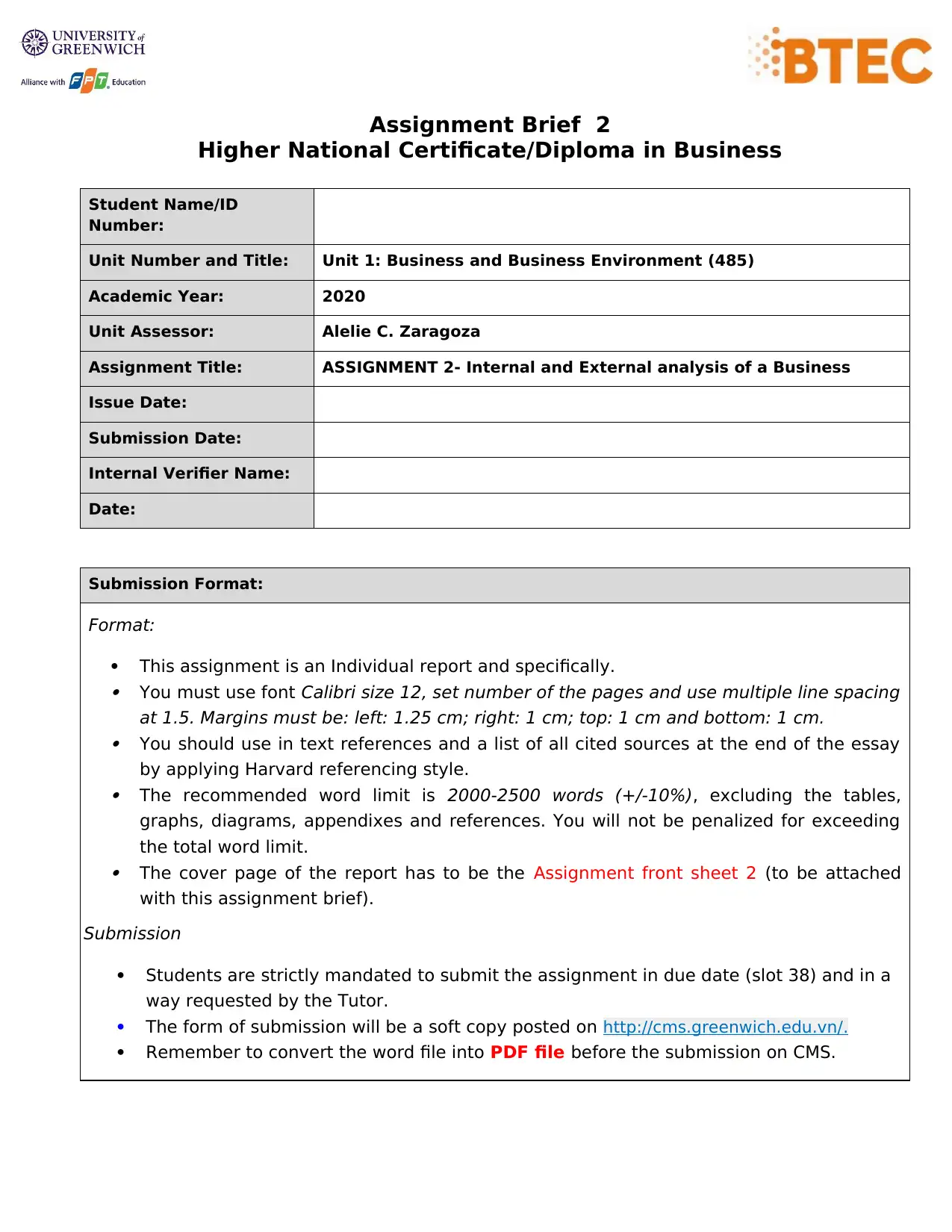
Assignment Brief 2
Higher National Certificate/Diploma in Business
Student Name/ID
Number:
Unit Number and Title: Unit 1: Business and Business Environment (485)
Academic Year: 2020
Unit Assessor: Alelie C. Zaragoza
Assignment Title: ASSIGNMENT 2- Internal and External analysis of a Business
Issue Date:
Submission Date:
Internal Verifier Name:
Date:
Submission Format:
Format:
This assignment is an Individual report and specifically. You must use font Calibri size 12, set number of the pages and use multiple line spacing
at 1.5. Margins must be: left: 1.25 cm; right: 1 cm; top: 1 cm and bottom: 1 cm. You should use in text references and a list of all cited sources at the end of the essay
by applying Harvard referencing style. The recommended word limit is 2000-2500 words (+/-10%), excluding the tables,
graphs, diagrams, appendixes and references. You will not be penalized for exceeding
the total word limit. The cover page of the report has to be the Assignment front sheet 2 (to be attached
with this assignment brief).
Submission
Students are strictly mandated to submit the assignment in due date (slot 38) and in a
way requested by the Tutor.
The form of submission will be a soft copy posted on http://cms.greenwich.edu.vn/.
Remember to convert the word file into PDF file before the submission on CMS.
Higher National Certificate/Diploma in Business
Student Name/ID
Number:
Unit Number and Title: Unit 1: Business and Business Environment (485)
Academic Year: 2020
Unit Assessor: Alelie C. Zaragoza
Assignment Title: ASSIGNMENT 2- Internal and External analysis of a Business
Issue Date:
Submission Date:
Internal Verifier Name:
Date:
Submission Format:
Format:
This assignment is an Individual report and specifically. You must use font Calibri size 12, set number of the pages and use multiple line spacing
at 1.5. Margins must be: left: 1.25 cm; right: 1 cm; top: 1 cm and bottom: 1 cm. You should use in text references and a list of all cited sources at the end of the essay
by applying Harvard referencing style. The recommended word limit is 2000-2500 words (+/-10%), excluding the tables,
graphs, diagrams, appendixes and references. You will not be penalized for exceeding
the total word limit. The cover page of the report has to be the Assignment front sheet 2 (to be attached
with this assignment brief).
Submission
Students are strictly mandated to submit the assignment in due date (slot 38) and in a
way requested by the Tutor.
The form of submission will be a soft copy posted on http://cms.greenwich.edu.vn/.
Remember to convert the word file into PDF file before the submission on CMS.
⊘ This is a preview!⊘
Do you want full access?
Subscribe today to unlock all pages.

Trusted by 1+ million students worldwide
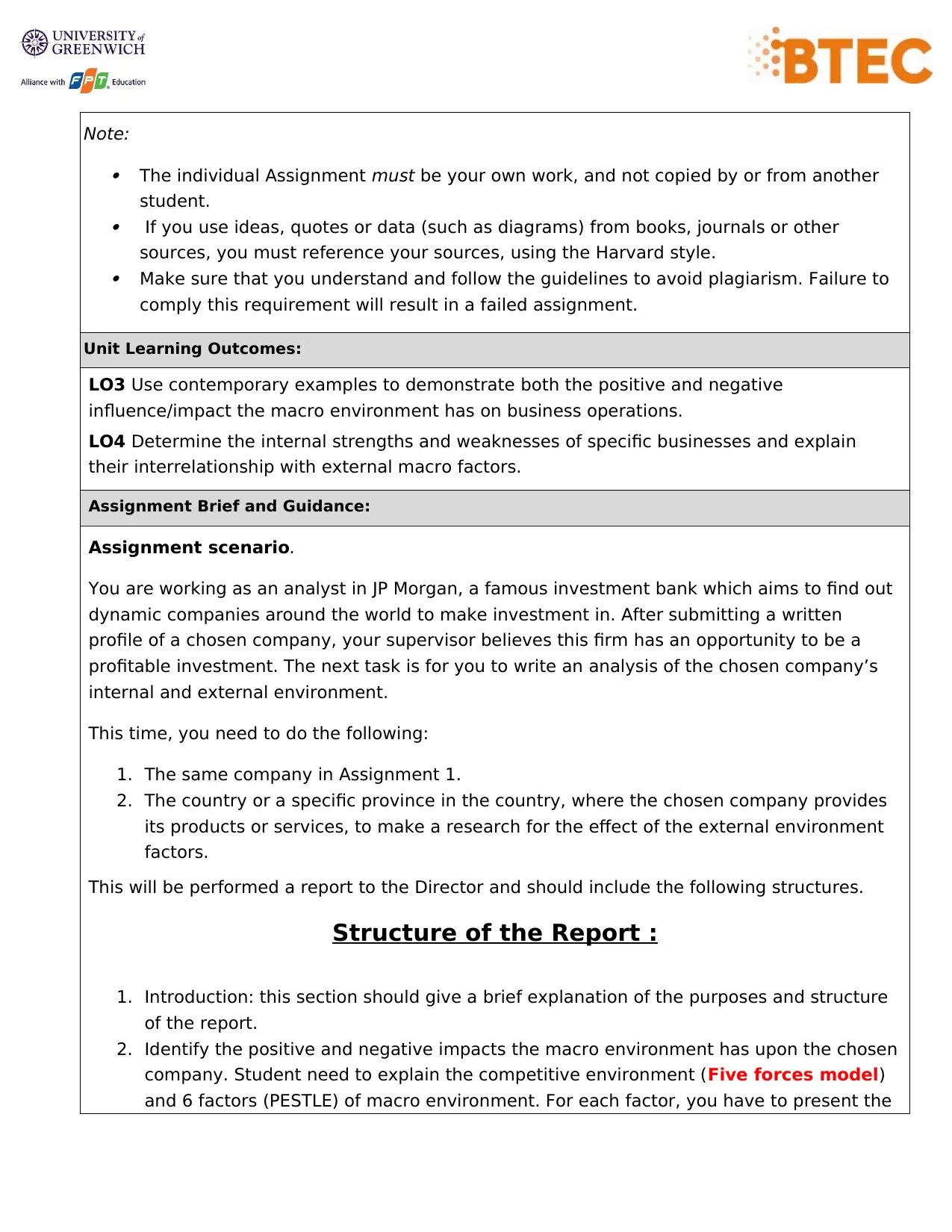
Note:
The individual Assignment must be your own work, and not copied by or from another
student. If you use ideas, quotes or data (such as diagrams) from books, journals or other
sources, you must reference your sources, using the Harvard style. Make sure that you understand and follow the guidelines to avoid plagiarism. Failure to
comply this requirement will result in a failed assignment.
Unit Learning Outcomes:
LO3 Use contemporary examples to demonstrate both the positive and negative
influence/impact the macro environment has on business operations.
LO4 Determine the internal strengths and weaknesses of specific businesses and explain
their interrelationship with external macro factors.
Assignment Brief and Guidance:
Assignment scenario.
You are working as an analyst in JP Morgan, a famous investment bank which aims to find out
dynamic companies around the world to make investment in. After submitting a written
profile of a chosen company, your supervisor believes this firm has an opportunity to be a
profitable investment. The next task is for you to write an analysis of the chosen company’s
internal and external environment.
This time, you need to do the following:
1. The same company in Assignment 1.
2. The country or a specific province in the country, where the chosen company provides
its products or services, to make a research for the effect of the external environment
factors.
This will be performed a report to the Director and should include the following structures.
Structure of the Report :
1. Introduction: this section should give a brief explanation of the purposes and structure
of the report.
2. Identify the positive and negative impacts the macro environment has upon the chosen
company. Student need to explain the competitive environment (Five forces model)
and 6 factors (PESTLE) of macro environment. For each factor, you have to present the
The individual Assignment must be your own work, and not copied by or from another
student. If you use ideas, quotes or data (such as diagrams) from books, journals or other
sources, you must reference your sources, using the Harvard style. Make sure that you understand and follow the guidelines to avoid plagiarism. Failure to
comply this requirement will result in a failed assignment.
Unit Learning Outcomes:
LO3 Use contemporary examples to demonstrate both the positive and negative
influence/impact the macro environment has on business operations.
LO4 Determine the internal strengths and weaknesses of specific businesses and explain
their interrelationship with external macro factors.
Assignment Brief and Guidance:
Assignment scenario.
You are working as an analyst in JP Morgan, a famous investment bank which aims to find out
dynamic companies around the world to make investment in. After submitting a written
profile of a chosen company, your supervisor believes this firm has an opportunity to be a
profitable investment. The next task is for you to write an analysis of the chosen company’s
internal and external environment.
This time, you need to do the following:
1. The same company in Assignment 1.
2. The country or a specific province in the country, where the chosen company provides
its products or services, to make a research for the effect of the external environment
factors.
This will be performed a report to the Director and should include the following structures.
Structure of the Report :
1. Introduction: this section should give a brief explanation of the purposes and structure
of the report.
2. Identify the positive and negative impacts the macro environment has upon the chosen
company. Student need to explain the competitive environment (Five forces model)
and 6 factors (PESTLE) of macro environment. For each factor, you have to present the
Paraphrase This Document
Need a fresh take? Get an instant paraphrase of this document with our AI Paraphraser
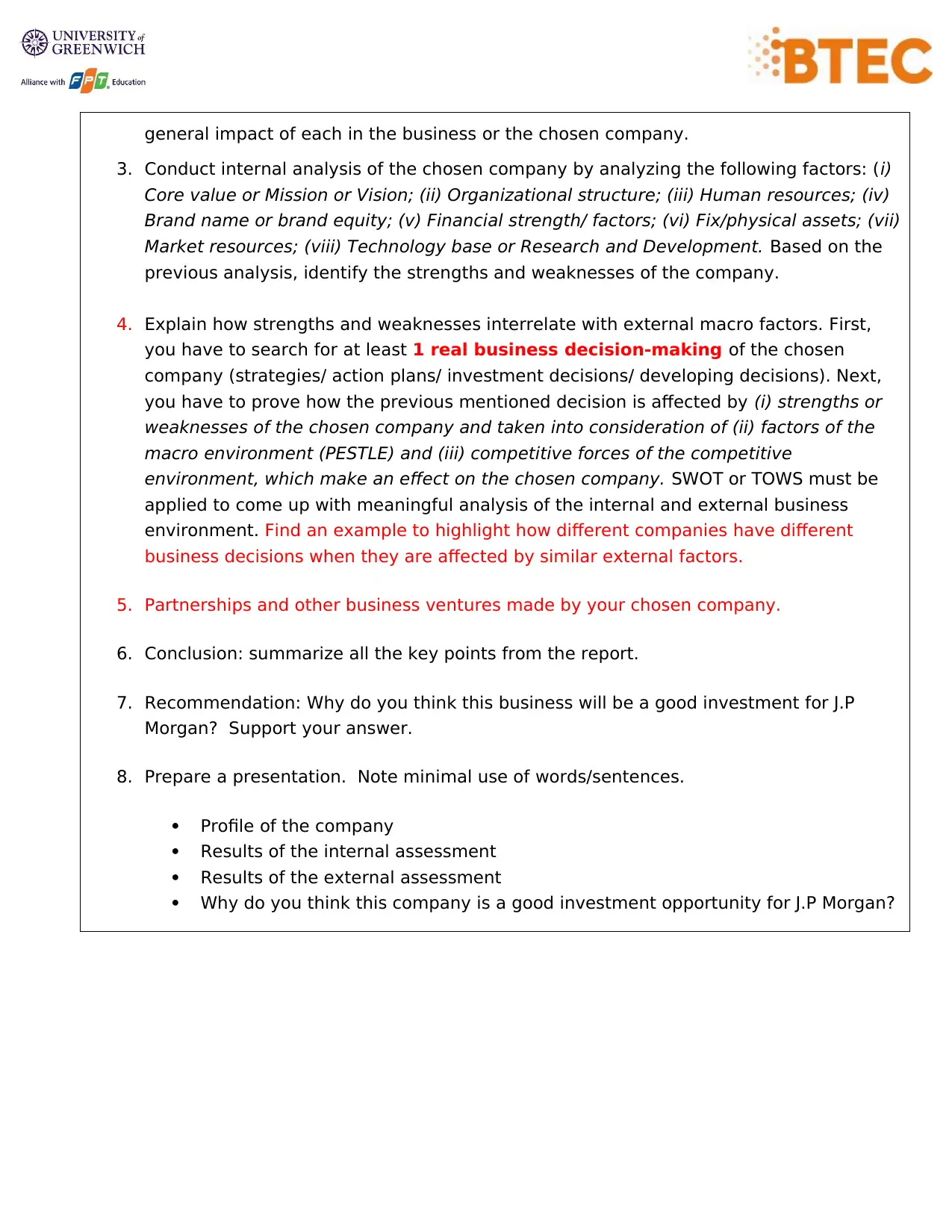
general impact of each in the business or the chosen company.
3. Conduct internal analysis of the chosen company by analyzing the following factors: (i)
Core value or Mission or Vision; (ii) Organizational structure; (iii) Human resources; (iv)
Brand name or brand equity; (v) Financial strength/ factors; (vi) Fix/physical assets; (vii)
Market resources; (viii) Technology base or Research and Development. Based on the
previous analysis, identify the strengths and weaknesses of the company.
4. Explain how strengths and weaknesses interrelate with external macro factors. First,
you have to search for at least 1 real business decision-making of the chosen
company (strategies/ action plans/ investment decisions/ developing decisions). Next,
you have to prove how the previous mentioned decision is affected by (i) strengths or
weaknesses of the chosen company and taken into consideration of (ii) factors of the
macro environment (PESTLE) and (iii) competitive forces of the competitive
environment, which make an effect on the chosen company. SWOT or TOWS must be
applied to come up with meaningful analysis of the internal and external business
environment. Find an example to highlight how different companies have different
business decisions when they are affected by similar external factors.
5. Partnerships and other business ventures made by your chosen company.
6. Conclusion: summarize all the key points from the report.
7. Recommendation: Why do you think this business will be a good investment for J.P
Morgan? Support your answer.
8. Prepare a presentation. Note minimal use of words/sentences.
Profile of the company
Results of the internal assessment
Results of the external assessment
Why do you think this company is a good investment opportunity for J.P Morgan?
3. Conduct internal analysis of the chosen company by analyzing the following factors: (i)
Core value or Mission or Vision; (ii) Organizational structure; (iii) Human resources; (iv)
Brand name or brand equity; (v) Financial strength/ factors; (vi) Fix/physical assets; (vii)
Market resources; (viii) Technology base or Research and Development. Based on the
previous analysis, identify the strengths and weaknesses of the company.
4. Explain how strengths and weaknesses interrelate with external macro factors. First,
you have to search for at least 1 real business decision-making of the chosen
company (strategies/ action plans/ investment decisions/ developing decisions). Next,
you have to prove how the previous mentioned decision is affected by (i) strengths or
weaknesses of the chosen company and taken into consideration of (ii) factors of the
macro environment (PESTLE) and (iii) competitive forces of the competitive
environment, which make an effect on the chosen company. SWOT or TOWS must be
applied to come up with meaningful analysis of the internal and external business
environment. Find an example to highlight how different companies have different
business decisions when they are affected by similar external factors.
5. Partnerships and other business ventures made by your chosen company.
6. Conclusion: summarize all the key points from the report.
7. Recommendation: Why do you think this business will be a good investment for J.P
Morgan? Support your answer.
8. Prepare a presentation. Note minimal use of words/sentences.
Profile of the company
Results of the internal assessment
Results of the external assessment
Why do you think this company is a good investment opportunity for J.P Morgan?
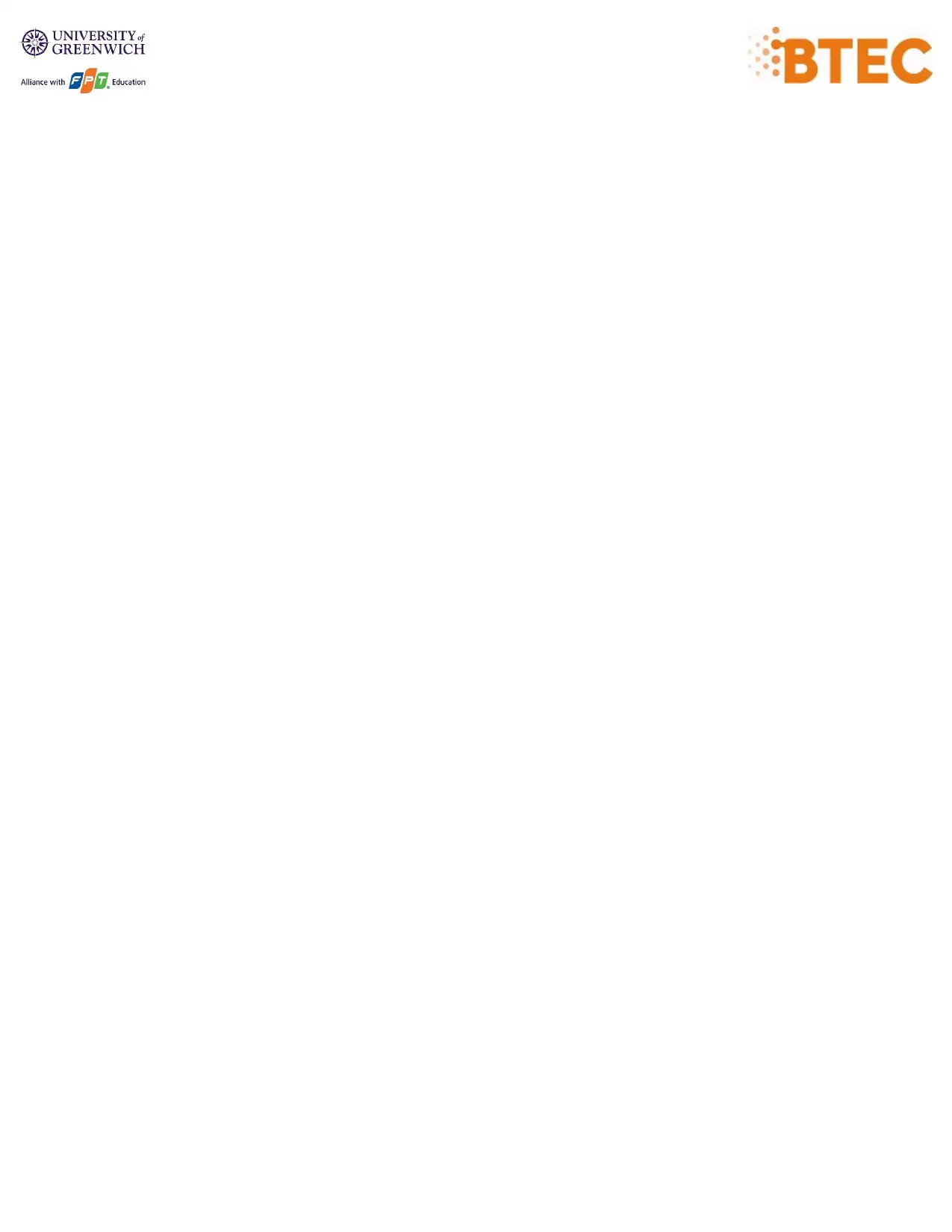
⊘ This is a preview!⊘
Do you want full access?
Subscribe today to unlock all pages.

Trusted by 1+ million students worldwide
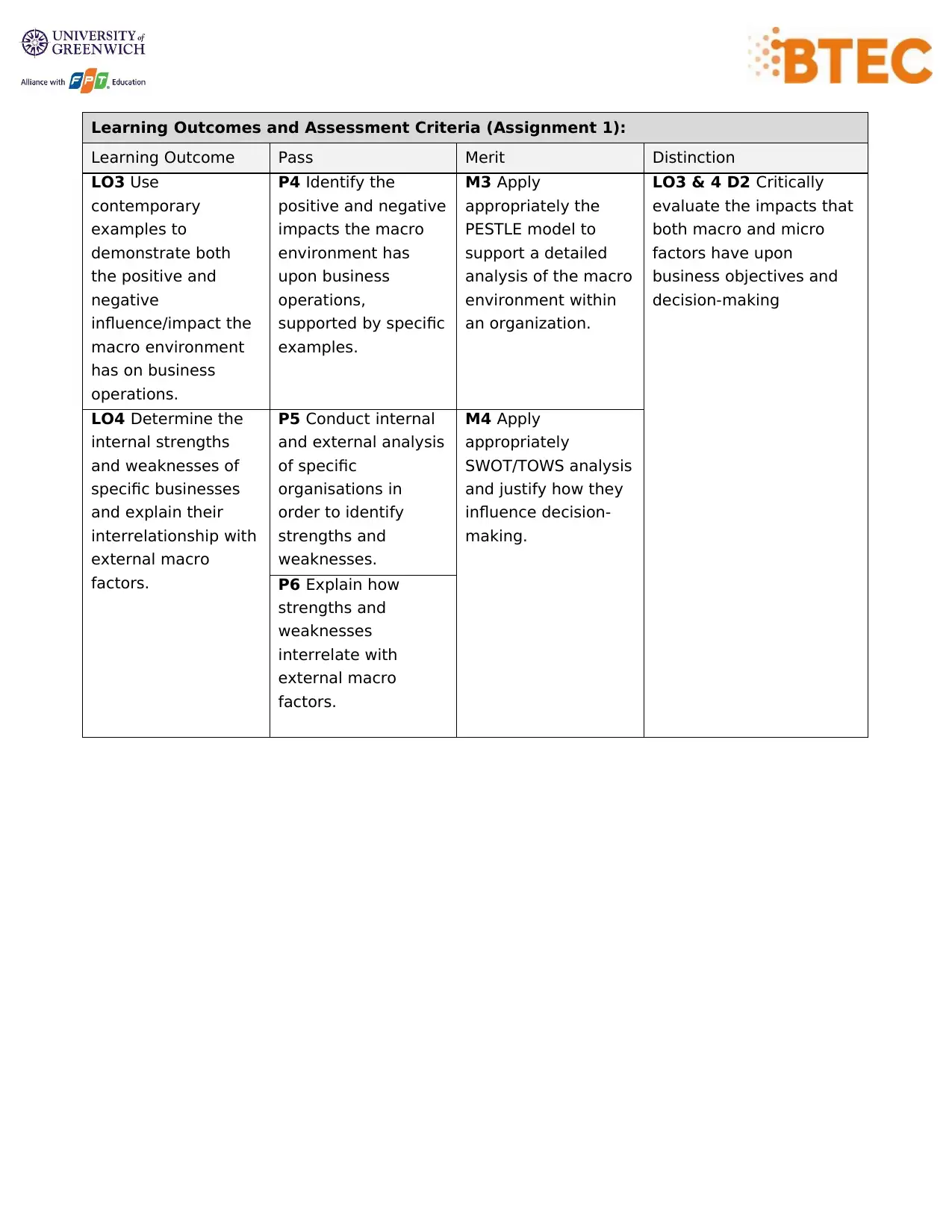
Learning Outcomes and Assessment Criteria (Assignment 1):
Learning Outcome Pass Merit Distinction
LO3 Use
contemporary
examples to
demonstrate both
the positive and
negative
influence/impact the
macro environment
has on business
operations.
P4 Identify the
positive and negative
impacts the macro
environment has
upon business
operations,
supported by specific
examples.
M3 Apply
appropriately the
PESTLE model to
support a detailed
analysis of the macro
environment within
an organization.
LO3 & 4 D2 Critically
evaluate the impacts that
both macro and micro
factors have upon
business objectives and
decision-making
LO4 Determine the
internal strengths
and weaknesses of
specific businesses
and explain their
interrelationship with
external macro
factors.
P5 Conduct internal
and external analysis
of specific
organisations in
order to identify
strengths and
weaknesses.
M4 Apply
appropriately
SWOT/TOWS analysis
and justify how they
influence decision-
making.
P6 Explain how
strengths and
weaknesses
interrelate with
external macro
factors.
Learning Outcome Pass Merit Distinction
LO3 Use
contemporary
examples to
demonstrate both
the positive and
negative
influence/impact the
macro environment
has on business
operations.
P4 Identify the
positive and negative
impacts the macro
environment has
upon business
operations,
supported by specific
examples.
M3 Apply
appropriately the
PESTLE model to
support a detailed
analysis of the macro
environment within
an organization.
LO3 & 4 D2 Critically
evaluate the impacts that
both macro and micro
factors have upon
business objectives and
decision-making
LO4 Determine the
internal strengths
and weaknesses of
specific businesses
and explain their
interrelationship with
external macro
factors.
P5 Conduct internal
and external analysis
of specific
organisations in
order to identify
strengths and
weaknesses.
M4 Apply
appropriately
SWOT/TOWS analysis
and justify how they
influence decision-
making.
P6 Explain how
strengths and
weaknesses
interrelate with
external macro
factors.
Paraphrase This Document
Need a fresh take? Get an instant paraphrase of this document with our AI Paraphraser
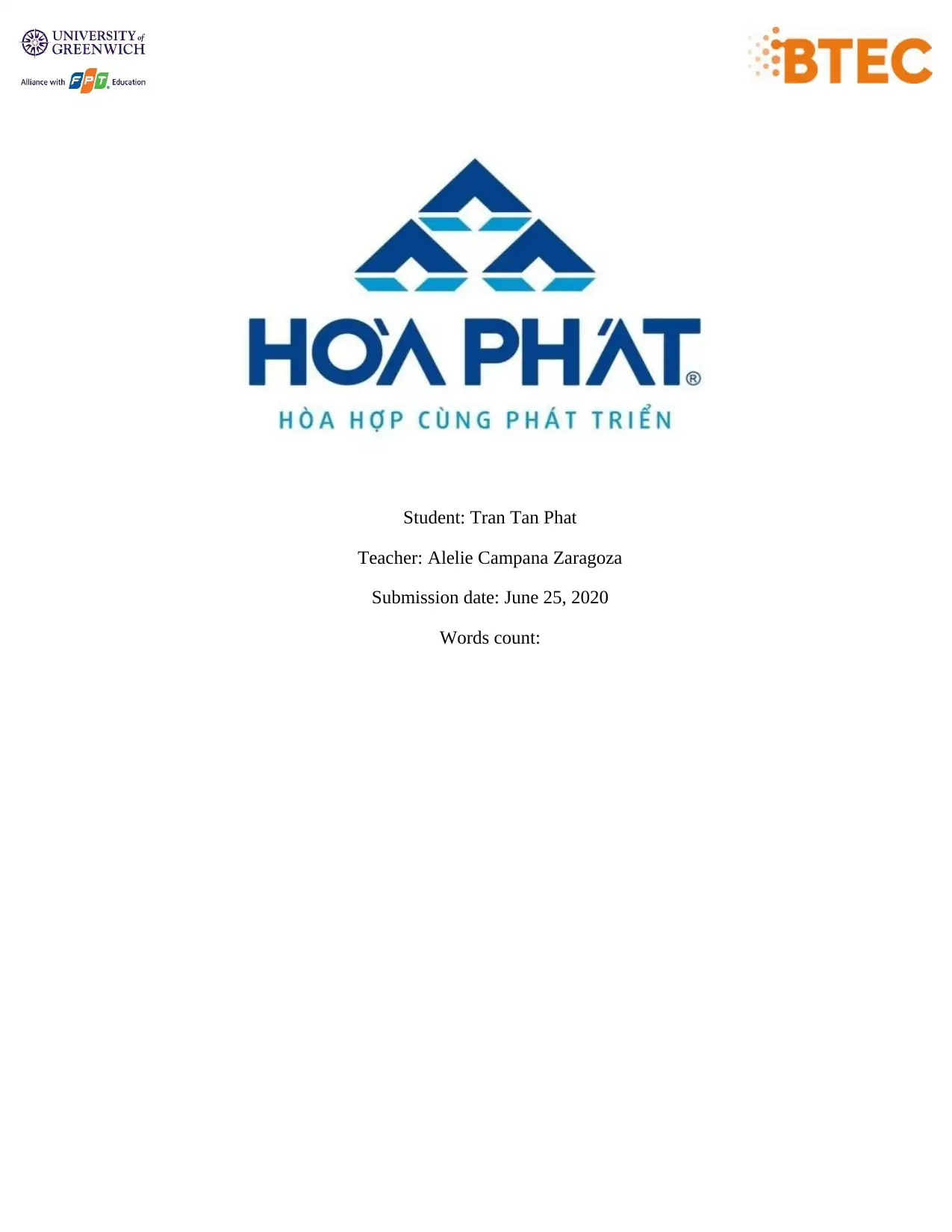
Student: Tran Tan Phat
Teacher: Alelie Campana Zaragoza
Submission date: June 25, 2020
Words count:
Teacher: Alelie Campana Zaragoza
Submission date: June 25, 2020
Words count:
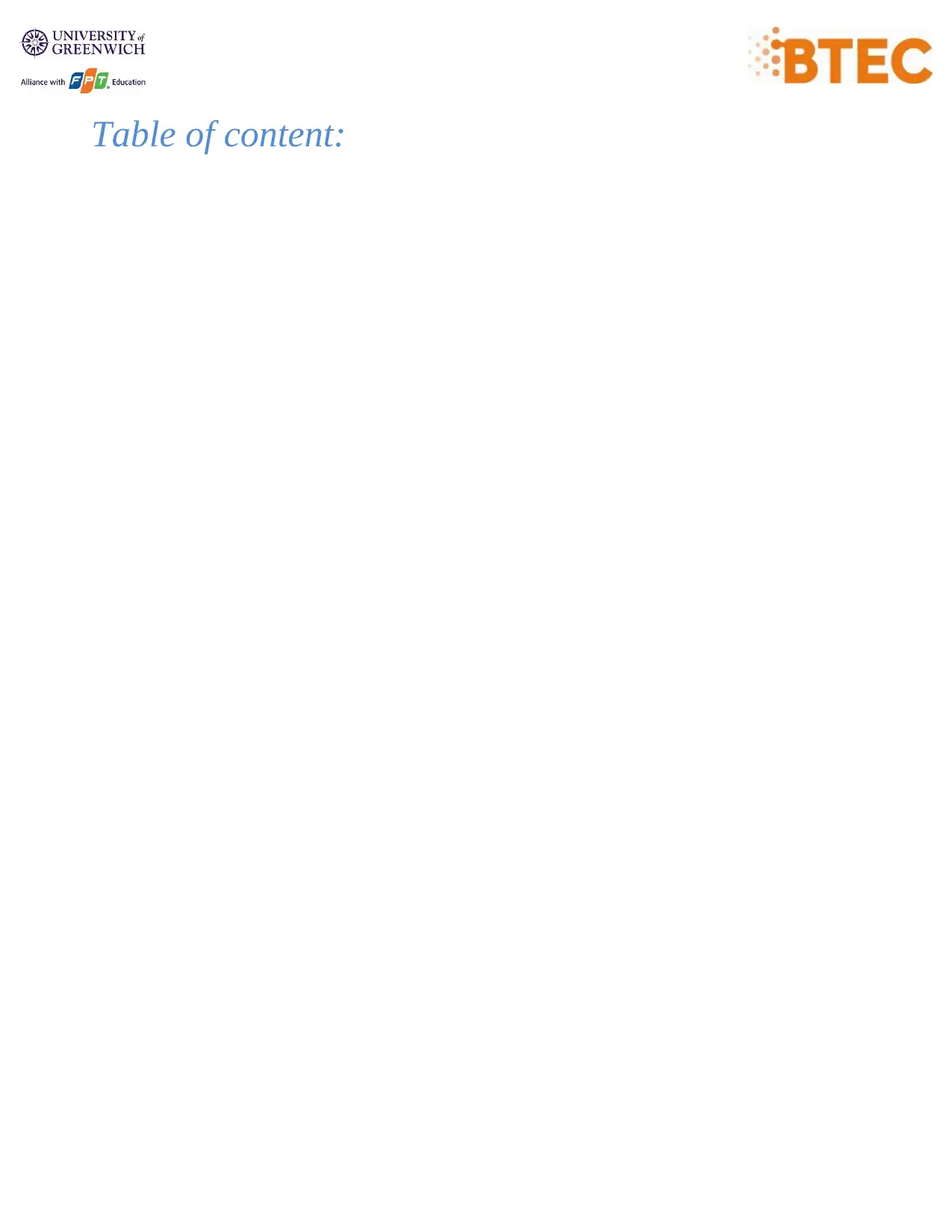
Table of content:
⊘ This is a preview!⊘
Do you want full access?
Subscribe today to unlock all pages.

Trusted by 1+ million students worldwide
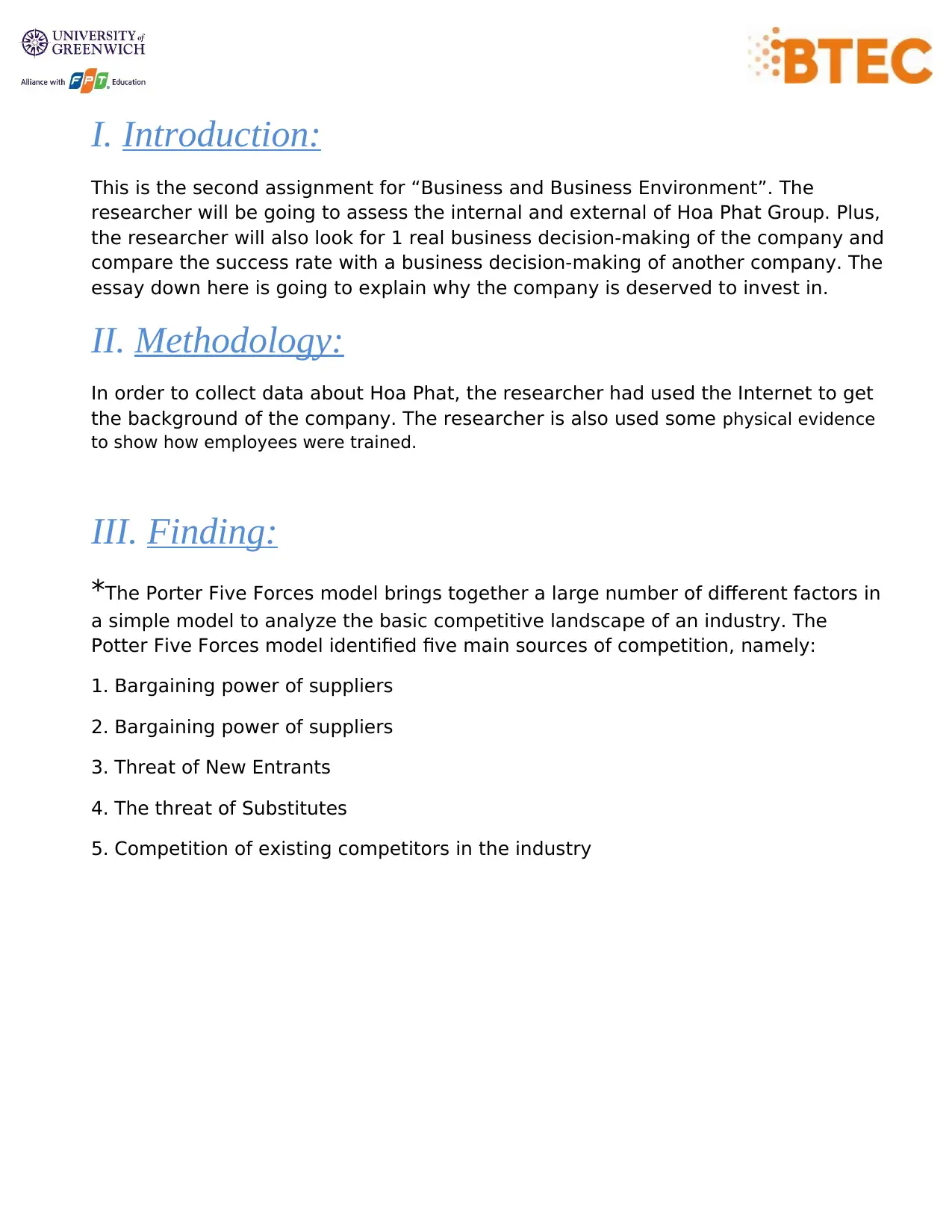
I. Introduction:
This is the second assignment for “Business and Business Environment”. The
researcher will be going to assess the internal and external of Hoa Phat Group. Plus,
the researcher will also look for 1 real business decision-making of the company and
compare the success rate with a business decision-making of another company. The
essay down here is going to explain why the company is deserved to invest in.
II. Methodology:
In order to collect data about Hoa Phat, the researcher had used the Internet to get
the background of the company. The researcher is also used some physical evidence
to show how employees were trained.
III. Finding:
*The Porter Five Forces model brings together a large number of different factors in
a simple model to analyze the basic competitive landscape of an industry. The
Potter Five Forces model identified five main sources of competition, namely:
1. Bargaining power of suppliers
2. Bargaining power of suppliers
3. Threat of New Entrants
4. The threat of Substitutes
5. Competition of existing competitors in the industry
This is the second assignment for “Business and Business Environment”. The
researcher will be going to assess the internal and external of Hoa Phat Group. Plus,
the researcher will also look for 1 real business decision-making of the company and
compare the success rate with a business decision-making of another company. The
essay down here is going to explain why the company is deserved to invest in.
II. Methodology:
In order to collect data about Hoa Phat, the researcher had used the Internet to get
the background of the company. The researcher is also used some physical evidence
to show how employees were trained.
III. Finding:
*The Porter Five Forces model brings together a large number of different factors in
a simple model to analyze the basic competitive landscape of an industry. The
Potter Five Forces model identified five main sources of competition, namely:
1. Bargaining power of suppliers
2. Bargaining power of suppliers
3. Threat of New Entrants
4. The threat of Substitutes
5. Competition of existing competitors in the industry
Paraphrase This Document
Need a fresh take? Get an instant paraphrase of this document with our AI Paraphraser
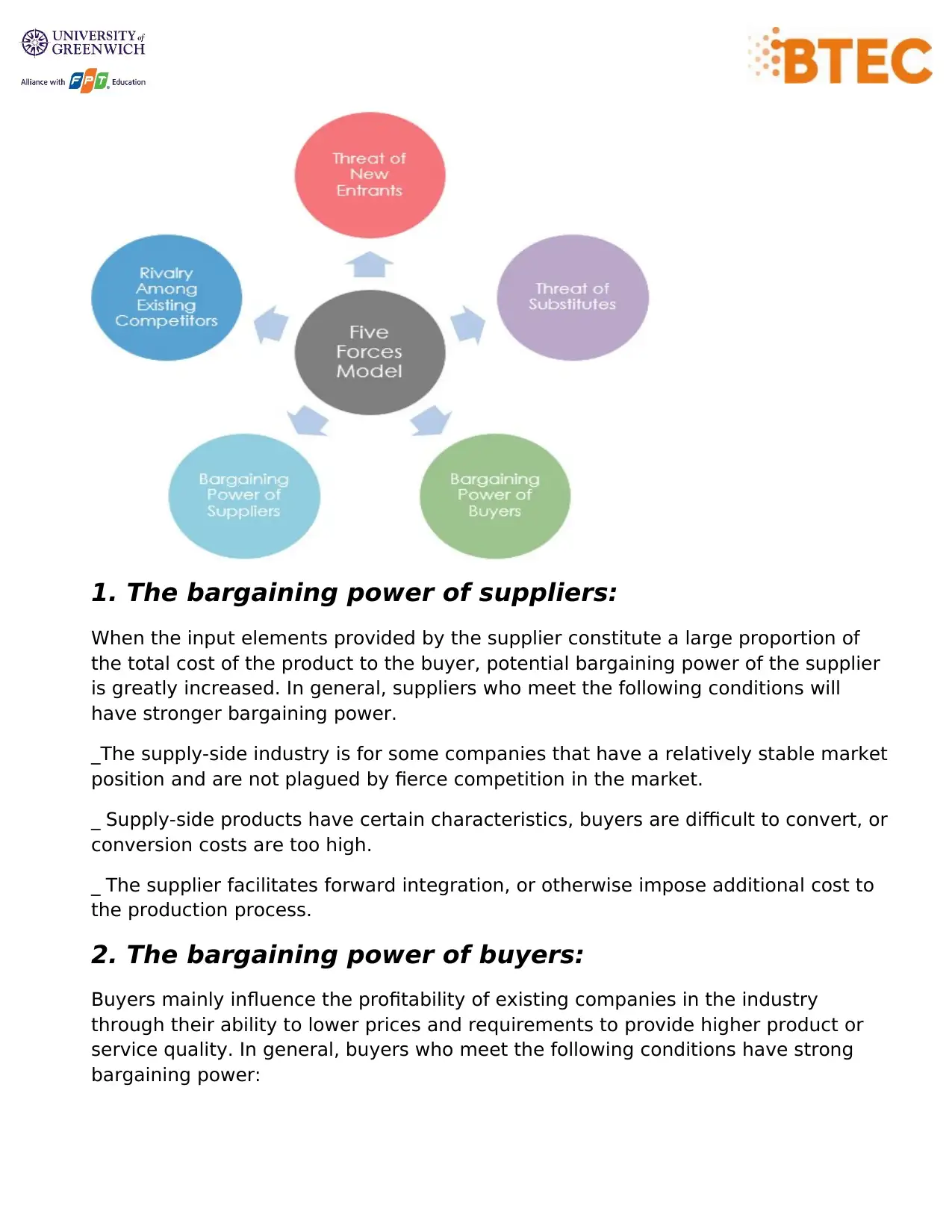
1. The bargaining power of suppliers:
When the input elements provided by the supplier constitute a large proportion of
the total cost of the product to the buyer, potential bargaining power of the supplier
is greatly increased. In general, suppliers who meet the following conditions will
have stronger bargaining power.
_The supply-side industry is for some companies that have a relatively stable market
position and are not plagued by fierce competition in the market.
_ Supply-side products have certain characteristics, buyers are difficult to convert, or
conversion costs are too high.
_ The supplier facilitates forward integration, or otherwise impose additional cost to
the production process.
2. The bargaining power of buyers:
Buyers mainly influence the profitability of existing companies in the industry
through their ability to lower prices and requirements to provide higher product or
service quality. In general, buyers who meet the following conditions have strong
bargaining power:
When the input elements provided by the supplier constitute a large proportion of
the total cost of the product to the buyer, potential bargaining power of the supplier
is greatly increased. In general, suppliers who meet the following conditions will
have stronger bargaining power.
_The supply-side industry is for some companies that have a relatively stable market
position and are not plagued by fierce competition in the market.
_ Supply-side products have certain characteristics, buyers are difficult to convert, or
conversion costs are too high.
_ The supplier facilitates forward integration, or otherwise impose additional cost to
the production process.
2. The bargaining power of buyers:
Buyers mainly influence the profitability of existing companies in the industry
through their ability to lower prices and requirements to provide higher product or
service quality. In general, buyers who meet the following conditions have strong
bargaining power:
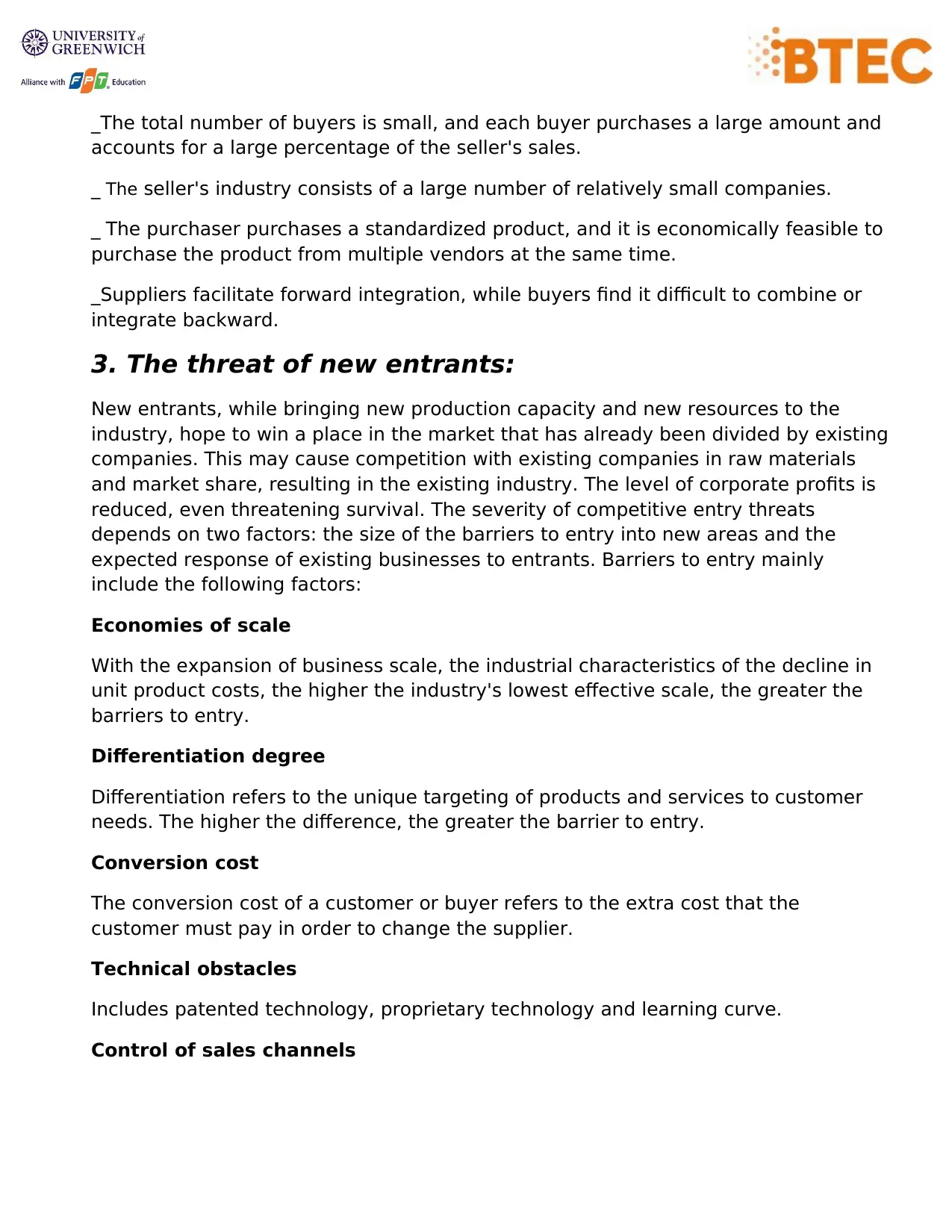
_The total number of buyers is small, and each buyer purchases a large amount and
accounts for a large percentage of the seller's sales.
_ The seller's industry consists of a large number of relatively small companies.
_ The purchaser purchases a standardized product, and it is economically feasible to
purchase the product from multiple vendors at the same time.
_Suppliers facilitate forward integration, while buyers find it difficult to combine or
integrate backward.
3. The threat of new entrants:
New entrants, while bringing new production capacity and new resources to the
industry, hope to win a place in the market that has already been divided by existing
companies. This may cause competition with existing companies in raw materials
and market share, resulting in the existing industry. The level of corporate profits is
reduced, even threatening survival. The severity of competitive entry threats
depends on two factors: the size of the barriers to entry into new areas and the
expected response of existing businesses to entrants. Barriers to entry mainly
include the following factors:
Economies of scale
With the expansion of business scale, the industrial characteristics of the decline in
unit product costs, the higher the industry's lowest effective scale, the greater the
barriers to entry.
Differentiation degree
Differentiation refers to the unique targeting of products and services to customer
needs. The higher the difference, the greater the barrier to entry.
Conversion cost
The conversion cost of a customer or buyer refers to the extra cost that the
customer must pay in order to change the supplier.
Technical obstacles
Includes patented technology, proprietary technology and learning curve.
Control of sales channels
accounts for a large percentage of the seller's sales.
_ The seller's industry consists of a large number of relatively small companies.
_ The purchaser purchases a standardized product, and it is economically feasible to
purchase the product from multiple vendors at the same time.
_Suppliers facilitate forward integration, while buyers find it difficult to combine or
integrate backward.
3. The threat of new entrants:
New entrants, while bringing new production capacity and new resources to the
industry, hope to win a place in the market that has already been divided by existing
companies. This may cause competition with existing companies in raw materials
and market share, resulting in the existing industry. The level of corporate profits is
reduced, even threatening survival. The severity of competitive entry threats
depends on two factors: the size of the barriers to entry into new areas and the
expected response of existing businesses to entrants. Barriers to entry mainly
include the following factors:
Economies of scale
With the expansion of business scale, the industrial characteristics of the decline in
unit product costs, the higher the industry's lowest effective scale, the greater the
barriers to entry.
Differentiation degree
Differentiation refers to the unique targeting of products and services to customer
needs. The higher the difference, the greater the barrier to entry.
Conversion cost
The conversion cost of a customer or buyer refers to the extra cost that the
customer must pay in order to change the supplier.
Technical obstacles
Includes patented technology, proprietary technology and learning curve.
Control of sales channels
⊘ This is a preview!⊘
Do you want full access?
Subscribe today to unlock all pages.

Trusted by 1+ million students worldwide
1 out of 31
Related Documents
Your All-in-One AI-Powered Toolkit for Academic Success.
+13062052269
info@desklib.com
Available 24*7 on WhatsApp / Email
![[object Object]](/_next/static/media/star-bottom.7253800d.svg)
Unlock your academic potential
Copyright © 2020–2025 A2Z Services. All Rights Reserved. Developed and managed by ZUCOL.





